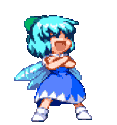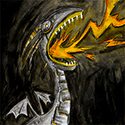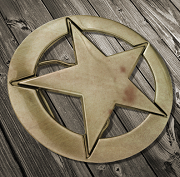|
So, I got invited to a 5e game, and I'm thinking of saying yes, just to see how it goes. I have low expectations, but hey, it might be a good group. What's the general consensus on Melee Classes? I remember hearing really good things about Valor Bards, are they still the top tier when it comes to melee? I think we've got a Cleric of War in our group, so I wouldn't want to step on his toes, but other than that, what's the go-to Beat People Up With Sticks class?
|
|
|
|

|
| # ? May 13, 2024 21:32 |
|
Gharbad the Weak posted:So, I got invited to a 5e game, and I'm thinking of saying yes, just to see how it goes. I have low expectations, but hey, it might be a good group. Valorous bards do literally everything there is to do in the game.
|
|
|
|
OneThousandMonkeys posted:The game would be vastly improved by cutting down on totally un-fun status effects--probably turning all stuns and dominates into dazes at most, for example [...] Almost the entire "control" aspect of the game was a mistake, in my opinion, outside of marking mechanics. There's so many layers of the metagame based around preventing your opponents from doing anything/preventing enemies from doing the same to you that it's really just too much. One idea from the Retrocloning 4E thread was to just collapse the status conditions to Prone, Restrained, Down (knocked out), Ongoing Damage and Mezzed, where Mezzed catches a lot of the control effects and simply grants Advantage to anyone attacking you and Disadvantage to everything you try to do while you have it.
|
|
|
|
If possible, I'd like to get as close to a 4e defender that these guys can get. Though, I do know with things like reactions being 1/round, etc etc, I'm going to be pretty limited, but I tend to enjoy being the tanky type. Edit: Though, if that's just not going to happen, I can certainly go towards Valor Bard. Is there a good example of a Valor Bard build? Gharbad the Weak fucked around with this message at 20:20 on Dec 24, 2014 |
|
|
|
Gharbad the Weak posted:If possible, I'd like to get as close to a 4e defender that these guys can get. Though, I do know with things like reactions being 1/round, etc etc, I'm going to be pretty limited, but I tend to enjoy being the tanky type. Totem Barbarian does pretty good tanky stuff. Allowing you to do stuff like take half damage from all sources and force disadvantage on hostiles that target a creature that is not you. (Does not have any range restrictions as well) At the same time you are a barbarian and you hit stuff pretty hard.
|
|
|
|
The most 4E Defender-ish things in Next are: Sentinel Feat: Hitting with an OA reduces the target's speed to 0, you can OA enemies even if they use Disengage, and you can OA a target if they're within 5 feet of you and they attack an ally that's not you. Shield Master Feat: using the Attack Action also lets you use a Bonus Action to Shove an enemy (and 2 other effects) Polearm Master Feat: enemies will provoke OAs when they enter your (5 foot) Reach (and 1 other effect) Mage Slayer Feat (distant 4th place): enemies will provoke OAs if they cast a spell while within 5 feet of you Marking Variant Rule: whenever a character makes a melee attack, it can choose to Mark its target. If the Mark provokes an OA, the Marker can take one OA against the Mark and it will have Advantage and will not consume the Marker's Reaction. That is, the Marker still has his Reaction and can make a Reaction-using OA against another provocation later in the round, but even if it's against the Mark it will not have the Advantage granted by the Mark rule. This effectively gives you two Reactions per round, provided that one is always an OA and is always against the Mark. Notice that none of these are specific to the Fighter or to any other class (and Marking has the potential of adding a shitload of combat processing overhead because it applies to everyone including monsters, if the DM decides to run it that way). EDIT: The Fighter has a Protection Fighting Style that lets you use your Reaction to cause an attacker to have Disadvantage on their attack roll if they attack a target that's not you, but it consumes your reaction and probably isn't going to be as useful as Sentinel simply letting you hit the guy at the same cost of burning your Reaction. Then you just use your Shield Master Bonus Action to Shove the guy on your turn. Unfortunately a Bard cannot get Proficiency with a Shield out of the box, and while a shapeshifted Druid is really tanky, it can't use a shield while it's a goddamn-bear either. Maybe a dip into Cleric for the Shield Proficiency? Other people would have a better idea for the specific CharOp steps, but the broad strokes are there. gradenko_2000 fucked around with this message at 20:44 on Dec 24, 2014 |
|
|
|
On second thought, I think Valor Bard is gonna be what I do. I'm just gonna be disappointed trying to make a 4e fighter in 5e, so I may as well play something that's a spellcaster.
|
|
|
|
Gharbad the Weak posted:On second thought, I think Valor Bard is gonna be what I do. I'm just gonna be disappointed trying to make a 4e fighter in 5e, so I may as well play something that's a spellcaster. Well you will never have all the options of the 4e fighter. But the Totem Barb with some of those feats does do a pretty good job. The Totem Barb impose disadvantage if they attack someone other they you is also passive and always on while you are raging. Also technically every class is a spellcaster. As every class has at least one subclass option to get them spells. The Barbarian does not get much however. Just a few rituals. Anyway Valor Bard is a great class choice. They can do well at anything in the game. They can't do everything at once nor will they be better then the other classes at their roles but they do them well. Like say every other class had 100 in their main role (This is just hypothetical some classes are better in roles then other.) The Bard has like a 70 in every role.
|
|
|
|
Sanglorian posted:Elemental: Death Throws Okay this is the sort of poo poo that only a pedant would care about, but is this a legitimate thing of it's own now and referencing something I don't know about, or is it just a really common misspelling of 'death throes'?
|
|
|
gradenko_2000 posted:The most 4E Defender-ish things in Next are: But yeah, you'll probably have a ton of fun with the Valor bard.
|
|
|
|
|
Also, guidance cantrip is pretty broken. Unlimited uses per day, +1d4. The only downside (aside from being bad design) is having the cleric player constantly saying 'I cast guidance to help' gets old.
|
|
|
|
I'd strike that cleric down, drat the alignments, if he was bugging me that much for "guidance".
|
|
|
|
It's terrible game design. Like Mearls made this big deal of going "If people want to make the game unfun then that's their call, we support their ability to do that," which betrays both a terrible business sense and a complete lack of understanding of how human beings work. Like, loving of course people are going to do whatever is the most powerful option. If that's also the least fun option, they will then justifiably call your game lovely and unfun, because you mechanically rewarded unfun things. Casting Guidance for basically everything is really dumb and unfun. It's also precisely what the game rewards you for doing.
|
|
|
|
Crasical posted:Okay this is the sort of poo poo that only a pedant would care about, but is this a legitimate thing of it's own now and referencing something I don't know about, or is it just a really common misspelling of 'death throes'? Haha, no - I just goofed.
|
|
|
|
ProfessorCirno posted:Casting Guidance for basically everything is really dumb and unfun. It's also precisely what the game rewards you for doing. For what it's worth, Dungeon Crawl Stone Soup explicitly takes out anything that incentivizes unfun play because they recognize it's bad design. And that's a tiny open-source roguelike.
|
|
|
|
I've been gifted the big three books for this version of D&D, are there any things I should know before I start studying? Broad strokes paint the fence faster, so if there are exceptions to general rules, that's fine, just give me the short version. I've played DnD 4e, Pathfinder, new World of Darkness, and FAE, if that tells you anything about stuff I'm used to.
|
|
|
|
Basic concept - Proficiency: This is a bonus that starts out at +2 at level 1 and goes up to +6 by the level cap Non-combat task resolution: There are 18 different skills in the game, each of them tied to one of the six attributes. Selecting a Class will make you Proficient in 4 skills. Selecting a Background will make you Proficient in 2 more. When you want to do a thing, roll a d20, add the corresponding attribute modifier, and also add your Proficiency bonus if you are Proficient in the corresponding skill. Meet or beat the DC set by the DM to succeed. Basic Combat Resolution: When you want to attack, roll a d20, add your STR or DEX modifier, and also your Proficiency bonus. Meet or beat the AC of the target to hit, then roll damage dice to deal damage. Basic spellcasting: If the spell description classifies it as a "spell attack", then it's actually like a physical/normal attack, except you add your spellcasting attribute (INT, WIS or CHA depending on class) instead of STR or DEX, but you're still aiming to beat the target's AC. If the spell description refers to a saving throw, then you cast the spell with a DC of (8+Proficiency+Spellcasting Attribute Modifier). The target then has to make a saving throw of (d20+Attribute Modifier). If the target is Proficient in the saving throw for that attribute (every class is Proficient in two out of the six), then the target gets to add their Proficiency bonus to the saving throw as well. They need to meet or beat your DC. That's basically it. The big gimmick is that since attribute modifiers only go up to +5 and Proficiency bonuses only go up to +6 at max, the Easy, Medium and Hard DCs generally don't have to be adjusted, and attack bonuses and ACs don't rise a lot, such as ACs capping out at 19.
|
|
|
|
How do actions work (like, 4e had standard+move+minor; 3.5 had full-round/move+standard, one swift, and one five-foot-step if you didn't move -- how does Next do it?), and what's up with attacks of opportunity in this edition?
|
|
|
|
Iny posted:How do actions work (like, 4e had standard+move+minor; 3.5 had full-round/move+standard, one swift, and one five-foot-step if you didn't move -- how does Next do it?), and what's up with attacks of opportunity in this edition? Pretty much exactly the same as 4E except minor actions are called bonus actions now.
|
|
|
|
goldjas posted:Pretty much exactly the same as 4E except minor actions are called bonus actions now. And no trading-down. And you can draw a weapon as part of your Action and as part of your Move.. Right?
|
|
|
|
Also, there are no move *actions* you just get x-ty feet (always in 5-foot increments, natch) of movement per round, which can be split up as you wish. So you can move-attack-move. Which is actually a bit of an improvement over 4e, both in terms of how it works, and the fact that it removes an explicit action from your turn, which makes things a little less complex.
|
|
|
|
gradenko_2000 posted:Valuable Summary This was really helpful, thanks!
|
|
|
|
Iny posted:How do actions work (like, 4e had standard+move+minor; 3.5 had full-round/move+standard, one swift, and one five-foot-step if you didn't move -- how does Next do it?), and what's up with attacks of opportunity in this edition? You get movement, a Normal Action, a Bonus Action, and a Reaction A. x squares worth of movement, average is 6 squares (30 feet) - the big gimmick is that you don't have to take all your movement at once. It's like a meter you run down - you can move 2 squares, take a Normal Action, move another 2 squares, take a Bonus Action, and then move another 2 squares, as long your total movement for the turn doesn't exceed your Speed B. Normal Action - things you can do with a Normal Action: 1. Attack - does what it says on the tin. If you're one of the classes that has Extra Attacks, this represents all of them. Note that some abilities either replace the whole Attack action, or just one of the attacks from it, or even are a rider on one of the attacks and doesn't replace any of them at all 2. Cast a Spell - self-explanatory 3. Dash - increases your movement by your Speed, effectively letting you move twice as far 4. Disengage - movement will not provoke Opportunity Attacks. Note that there is no "Shift" action in Next. In 4E, you could shift 1 square and then attack. In Next, you can move as far as your speed, but preventing OAs replaces being able to attack. 5. Dodge - Advantage on DEX saves. Attacks against you have Disadvantage on the attack roll. 6. Grapple - Make a STR(Athletics) check opposed by the target's STR(Athletics) or DEX(Acrobatics) check. If you roll higher, you Grapple the target 7. Escape Grapple - Make a STR(Athletics) or DEX(Acrobatics) check opposed by the target's STR(Athletics) check. If you roll higher, you are no longer Grappled 8. Help - Give Advantage to an ally's ability check or attack roll 9. Hide - Make a DEX(Stealth) check against a set DC. If you succeed, you become hidden 10. Shove - Make a STR(Athletics) check opposed by the target's STR(Athletics) or DEX(Acrobatics) check. If you roll higher, the target will either be knocked Prone or will have to move back 5 feet/1 square. 11. Ready Action - declare an action you want to take based on a trigger, and declare what the trigger will be. If the trigger happens on any other character's turn, you perform the action. This will consume your 1 Reaction per round 12. Most everything else as improvised by the player, such as searching an area, trying to heal an unconscious ally, using an object, etc. C. Bonus Action - abilities specify if they are to be used as Bonus Actions. One example of a standard Bonus Action is attacking with your off-hand weapon if you are dual-wielding. Since you only have 1 Bonus Action, if you have multiple abilities that need to be used as Bonus Actions, you can only use one of them. D. Reaction - abilities specify if they can be used as Reactions. One example of a standard Reaction is an Opportunity Attack, which is a basic melee attack roll whenever someone leaves your reach. The difference between this and a Normal Action to Ready an Action is that this can only be used with specific abilities that specify their usability as Reactions, whereas a Readied Action can be anything (at the expense of the player having to anticipate ahead of time what that action will be, and what will trigger it) gradenko_2000 fucked around with this message at 17:28 on Dec 25, 2014 |
|
|
|
You know, I kind of like the new action economy.
|
|
|
|
Azran posted:You know, I kind of like the new action economy. The PHB doesn't, at least in my opinion, do a good job of telegraphing it well, but it really is rather simple and my one gripe with that aspect of the game specifically is the Reactions being limited to one per turn with no way of increasing it. I suppose they may have wanted to limit the number of Reactions to prevent rounds from taking too long, but it seems like a rather hamfisted way of doing so (and the game turning into rocket tag is another possible example of that)
|
|
|
|
Having played a bunch of different online CCGs and the Talisman board game, I can honestly say scrapping and minimizing multiple out of turn reactions is a good thing. Better to handle marks with a conditional damage aura.
|
|
|
|
ascendance posted:Having played a bunch of different online CCGs and the Talisman board game, I can honestly say scrapping and minimizing multiple out of turn reactions is a good thing. Well, you want players to not be totally bored outside their turn. Settlers does a good job of that.
|
|
|
|
Tunicate posted:Well, you want players to not be totally bored outside their turn. Settlers does a good job of that.
|
|
|
|
The more I read about Legend (d20), the more similarities I see between it and Next. F&F writeup 1, F&F writeup 2 * Classes choose from 1 of 3 different "tracks" that dole out special abilities every few levels. The lack of a Fighter in Legend is either genius or simply a notable omission, depending on your POV * Skill points have been dumped in favor of simply being "Trained" in a skill, or not. If you're Trained, you can add your level as a modifier to the roll. If you're not, it's just [d20+ability modifier]. Next's Proficiency scales up slower, but then Legend advocates a "flat DC for a specific task" in the first place * No "spell attacks" nor cantrips in Legend, but instead spellcasters do get good BAB scaling * Abilities are classified as either per-encounter or per-scene, where a scene is defined as three encounters or a narrative rest of 2-4 hours. Spells/spell slots are recharged after a scene. One standout is that Legend actually has extensive discussions, guidelines and math on monster creation. I suppose this is not so much an indictment of either game and more a reflection on how these "Rule of Cool" developers beat WOTC to much the same design punch by about a year early. ascendance posted:Having played a bunch of different online CCGs and the Talisman board game, I can honestly say scrapping and minimizing multiple out of turn reactions is a good thing. Score another point for Jimbozig's Strike! simplifying Opportunity Attacks to "if you trigger an OA, you take damage, period"
|
|
|
|
The main problem with OA is that the game is built around single-hit attacks rapidly being outscaled in order to buff up the martial multiple attacks. Were the game built around everyone making an actual single attack on their turn, "one reaction per whatever" would work fine. As it is, OAs are neigh ignorable. For a punishment to work, they have to actually punish.
|
|
|
|
Marking is what OAs wanted to be. OAs are not good in the slightest. Even fighting withdraw was better. OAs present a problem to DMs: because the death of a single monster doesn't matter in the slightest, you just have the monsters stand still and fight to the death. Like critical hits, OAs hurt the players more than they help them. Then, because the idea that you can't disengage from an opponent is really dumb, they tacked on the stupid 5 foot step.
|
|
|
|
If I'm understanding you two correctly, the value of 4E's Mark+Combat Challenge+Combat Superiority was being able to stop a monster's movement and not the basic attack itself, because basic attacks represent smaller and smaller percentages of a monster's total HP? Then by that reasoning, the value in Next lies in Sentinel's reproduction of Combat Superiority (end movement on an OA hit) and Barbarian Bear Totem/Fighter Protection Style imposing Disadvantage on attack rolls against not-the-tank?
|
|
|
|
gradenko_2000 posted:Score another point for Jimbozig's Strike! simplifying Opportunity Attacks to "if you trigger an OA, you take damage, period" Yeah, being "you did the thing you know not to do; take damage" is a lot more elegant for an off-turn action than having to roll an actual attack, especially if the damage scales properly. ProfessorCirno posted:The main problem with OA is that the game is built around single-hit attacks rapidly being outscaled in order to buff up the martial multiple attacks. Were the game built around everyone making an actual single attack on their turn, "one reaction per whatever" would work fine. As it is, OAs are neigh ignorable. For a punishment to work, they have to actually punish. It'd be easy enough to be like "when you gain an Extra Attack, you also gain one additional Reaction per round to make an Opportunity Attack" or something. Not that I'm here to do Mearls' job for him. gradenko_2000 posted:If I'm understanding you two correctly, the value of 4E's Mark+Combat Challenge+Combat Superiority was being able to stop a monster's movement and not the basic attack itself, because basic attacks represent smaller and smaller percentages of a monster's total HP? Yeah, basically this. When marked, either you can attack the guy with high AC, or attack someone else at a penalty AND eat a whack. This is why Paladins got the shaft as Defenders in 4e; not only did their mark punishment not stop enemies from moving, the damage didn't scale worth a poo poo (which I guess was "balanced" because it was no-action auto-damage.) Then mix in feats for polearm hijinx and fighters got better. And then they forgot that you need STR for basic attacks, so they had to make the Melee Training feat.. 
|
|
|
|
It's worth noting that 4e Defender control gets increasingly better. We'll use the standard, classical, sword and board fighter. You start being able to smack anyone who tries to run past you and stopping their movement with your smack, AND 1/round smacking someone who tries to shift past you or attack someone else. Then you add a shield to their face, knocking them back a bit. As time goes by you add more to your shield to the face, until your 1/round OA and 1/turn combat challenge is smashing them so hard with your loving shield that they go flying back and are left both sprawled out on the floor. By Epic, if you're using a hammer, it gets even better, clubbing them over the head before shielding them to their stupid face. Being able to stop a monster's movement was only the first part. The real point was that you were the loving juggernaut of war, knocking fools around and out who tried to come close to your friends. Polearm fighters were controlling the fight and sliding enemies around exactly where they wanted them and ensuring full battlefield supremecy. Two handed fighters would just charge at you and drive their goddamn huge weapon through your legs, and walk away laughing while you were unable to move. Not to mention Fighters could choose to get weapons that flat out shut down teleporting, so there was NO ESCAPE once a fighter had you in his sights, no matter who or what you were. There was a steady and increasing level of "NO, gently caress YOU" that Fighters got as they leveled. Now in 5e, you have to take a specific ability just to get the initial Cool Fighter Thing, and it never gets better. 4e may as well have been Fighter Edition. 5e is it's antithesis. P.d0t posted:Yeah, basically this. When marked, either you can attack the guy with high AC, or attack someone else at a penalty AND eat a whack. This is why Paladins got the shaft as Defenders in 4e; not only did their mark punishment not stop enemies from moving, the damage didn't scale worth a poo poo (which I guess was "balanced" because it was no-action auto-damage.) To be fair, paladins get really, really nasty once you start adding multiple damage hits in different damage types to your punishment, and then give the baddies vulnerability. ProfessorCirno fucked around with this message at 20:58 on Dec 25, 2014 |
|
|
|
P.d0t posted:Yeah, basically this. When marked, either you can attack the guy with high AC, or attack someone else at a penalty AND eat a whack. This is why Paladins got the shaft as Defenders in 4e; not only did their mark punishment not stop enemies from moving, the damage didn't scale worth a poo poo (which I guess was "balanced" because it was no-action auto-damage.) 4e Paladins were kinda troubled out of the box but did get significantly better with later support. The damage got better with feats and items to the point where an Str/Cha paladin has some pretty painful (especially with Radiant Vulnerability in play), and then got other support like Bitter Challenge (violating the mark slows the target, which sets up for Proning with World Serpent's Grasp) and Weakening Challenge in Epic (weakens the target during the attack for half damage, which is fantastic), plus multi-marking from Divine Sanction powers. Most of this would have been nice to have earlier, but that's game design for you. Then they forgot half of this when they designed the cavalier, which has the low damage (not modified by anything else that boosts Divine Challenge/Sanction) and then adds in an opportunity action cost.
|
|
|
|
LightWarden posted:Most of this would have been nice to have earlier, but that's game design for you. Then they forgot half of this when they designed the cavalier, which has the low damage (not modified by anything else that boosts Divine Challenge/Sanction) and then adds in an opportunity action cost. Well it's not like Essentials was the high point of 4E's design in general.
|
|
|
|
I feel like 5e is an overreaction to the grog perception of 4e as fighter edition.
|
|
|
|
ascendance posted:I feel like 5e is an overreaction to the grog perception of 4e You could just say this, save some words and it holds about as true.
|
|
|
|
It's the same statement really. Nobody who hated 4e ever talks about rogues or rangers or clerics or...well, quite frankly, anything but fighters and wizards. Maybe the occasional Warlord hate from time to time, but by and large it's all down to fighters and wizards. Makes sense when you remember 3e being Wizard Supremecy, gently caress Fighters edition.
|
|
|
|

|
| # ? May 13, 2024 21:32 |
|
LightWarden posted:feats and items See, this is the problem I have with 4e. Some classes have to use their customization "options" in a very narrow way just to keep up, while others get to use them for expanding the breadth of their capabilities. In short, I don't see this as a feature. Not to say that 5e is in any way doing a better job of this; class balance is a joke.
|
|
|






















